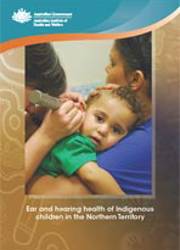Summary
The report presents data from the Australian Government-funded follow-up ear and hearing health services delivered through the Child Health Check Initiative (CHCI) and then the Closing the Gap (CtG) in the Northern Territory National Partnership Agreement. These services were made available to children in prescribed areas of the Northern Territory from August 2007. This report provides information on the following aspects of the program as delivered until May 2011:
- follow-up services provided to children with an audiology or ear, nose and throat referral from their Child Health Check (CHC)
- details of audiology and ENT services provided
- ear and hearing health status of children who received audiology and ENT services.
Key findings
- Among children who received an audiology or ENT referral during the CHCs, around 70% of children received the service for which they were referred, and the average waiting time between referral and service was 14.3 months for audiology services and 24.5 months for ENT services.
- Between August 2007 and May 2011, 7,421 audiology services and 3,840 ENT services were received by 4,993 and 2,670 children respectively.
- The high need for services is likely to continue into the near future. Among children who needed further services about 36% and 22% received the subsequent CHCI (CtG) audiology and ENT services respectively. For children who had an ENT operation, less than 60% received post-operation care through the CHCI (CtG) program. Some children, however, have received services through other programs, so the total number of children who received subsequent services may be underestimated. In total, by 31 May 2011, 2,020 children were on the waiting list for audiology services and 2,217 children required ENT consultations.
- About 66% of children who received an ENT consultation or an audiological assessment were diagnosed with at least one type of middle ear condition. The most common diagnoses were otitis media with effusion (OME), dry perforation and chronic suppurative otitis media (CSOM). The prevalence of CSOM among children who received services (12%) was three times the prevalence rate defined by the World Health Organization (WHO) as a massive public health problem (4%).
- Among children who received an audiology service, 53% had some form of hearing loss and 33% had hearing impairment. Around 11% had a level of hearing impairment (moderate, severe or profound) defined by the WHO as a disability, and without further intervention the development of these children will be affected.
- Of children who received two or more audiology or ENT services, there was a decline in the proportion with a middle ear condition (decreasing from 85% at first service to 70% at last service). The prevalence of hearing loss decreased from 70% at their first audiology service to 61% at their last service among children who received two or more audiology services. More than half the children (56%) who had hearing impairment at their first audiology check experienced an improvement.



